Calvin Craig’s garden 18 Mar 7:54 AM (last month)
Parking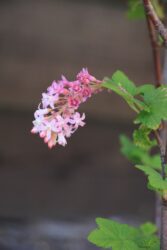
Park on West Shell Avenue
Showcase Feature
The parking strip in front of the house is bordered by fast-growing deergrass, a perennial that puts up graceful, two-foot-long golden plumes when in flower. Songbirds visit for its seeds. Behind the fence is a small secluded seating area planted with an attractive combination of grasslike, evergreen gray rush and the aromatic yerba buena.
Substantial mounds encircle the back garden—providing visual interest, and the drainage that most natives need—and they will create a privacy screen when mature. The mounds are planted with an attractive combination of apricot mallow, purple-flowering California lilac, lavender pitcher sage, red-flowering spice bush, fragrant low-growing yellow wooly sunflower, and yarrow, with its ferny leaves and cream-colored flowers—and more.
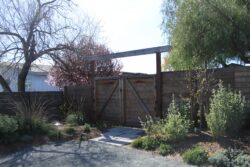 Other Garden Attractions
Other Garden Attractions
• Large, glazed pots contain wooly blue curls.
• The fruit trees (Bing cherry, Navel orange, apricot, lime) and the natives are on a separate irrigation zones.
• Rosy buckwheat flourish near the house.
Gardening for Wildlife
Hummingbirds, finches, butterflies and lizards frequent this garden. A bird bath provides much-needed water for our avian friends.
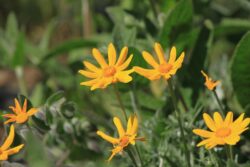 Dutchman’s pipevine waits hopefully for the large, iridescent blue-black pipevine swallowtail butterfly: pipevine is the only plant it can lay its eggs on.
Dutchman’s pipevine waits hopefully for the large, iridescent blue-black pipevine swallowtail butterfly: pipevine is the only plant it can lay its eggs on.
Keystone species (watch this talk by Doug Tallamy!)
Keystone species—our own, local ecological powerhouse plants—in this garden include California lilac, buckwheat, native strawberry, and penstemon.
At least partially wheelchair accessible? No
The post Calvin Craig’s garden appeared first on Bringing Back the Natives Garden Tour.
Carol Thornton’s garden 4 Mar 10:16 AM (last month)
Showcase Feature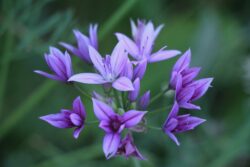
This charming, peaceful garden was created to provide habitat for wildlife. Large, blue black iridescent pipevine swallowtail butterflies lay their bright orange eggs on the Dutchman’s pipevine—the only plant they can reproduce on: look for their black and red caterpillars in the back garden. Monarch butterflies lay eggs on the narrow leaf milkweed—this is the only plant they can lay their eggs on: can you spot their black, white, and yellow caterpillars? The yampah meadow in the back garden invites swallowtail butterflies to lay their eggs there—can you see any of the green and black swallowtail caterpillars? (Yampah is one of the host plants for the beautiful yellow and black anise swallowtail butterfly—try growing yampah, instead of invasive, non-native fennel, to attract these butterflies to your garden.)
The front garden was designed decades ago by Glen Schneider—note the super-tall California lilac in front of the house, which Glen chose. The back garden was designed in 2019 by Todd Gilens of Todd Gilens Design, and installed by Todd and Carol.
Other Garden Attractions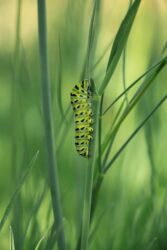
• Check out Carol’s “aromatherapy” chair: see if you can catch the scents of the native mock orange, hummingbird sage, and yerba buena, and also the pineapple sage and rose.
• This 100-year-old house was once the home of Wiley Manuel, the first African American to serve on California’s Supreme Court.
• Take a seat near the pond and relax near the splashing waterfall; you won’t want to leave.
Gardening for Wildlife
Four bird baths (one with a solar-powered bubbler), and two small ponds—one with a small waterfall—attract a variety of birds, and also diminutive, green Pacific chorus frogs. In late winter and early spring the male frogs sing to entice mates and protect their territory (you can hear their song here.)
A variety of birds are attracted to the sound of falling water, and also to the thicket of densely-planted shrubs—which not only gives birds safe places to rest and nest, but also functions as a privacy screen. Hummingbirds have nested right outside of Carol’s kitchen window. 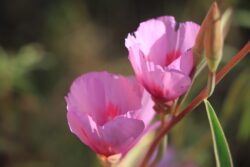
Brush and wood piles are home to small creatures like salamanders, spiders, and various insects seeking cool, shady places to rest. Carol leaves the leaves, as they are food and shelter for butterflies, beetles, bees, moths, and more. (Did you know that most butterflies and moths overwinter in leaf litter? Don’t throw them in your green waste bin! Leave the leaves to sustain the natural web of life.)
Carol’s cats are kept indoors to keep them, and the birds, safe.
Garden Talks
10:30 “Working with an existing garden” Designer/builder Todd Gilens will talk about choosing what to keep—and how to change—an already-established garden.
12:00 “The point of a garden is to be wonderful!” by Carol Thornton
“I used to worry about having the perfect garden, for me and for wildlife, but I’ve slowly let go of trying for perfection and of owning this space. I feel now that it belongs to all the creatures that call it home and those that are just passing through, not to me. My job is just to tend with a light hand. I’ve found that the letting go of control allows the wonder to take hold, and a deeper connection to the natural world is developing.
Another aspect I think about are the stories that our gardens hold. Mine has quite a few—Cooper’s hawk visits, a dead crow adventure, and cops and robbers—come to this talk and hear all about them!”
Keystone species (watch this talk by Doug Tallamy!)
Keystone species—our own, local ecological powerhouse plants— in this garden include holly leaf cherry, coast live oak, currant, gooseberry, serviceberry, manzanita, box elder, mountain mahogany, California rose, sage, creek dogwood, ocean spray, native strawberry, twinberry, honeysuckle, buckwheat, snowberry, and penstemon.
Green Home Features
A heat pump both heats and cools the house, and Carol cooks on an induction range. A passive hot water heater is located on the roof.
At least partially wheelchair accessible? Yes
The post Carol Thornton’s garden appeared first on Bringing Back the Natives Garden Tour.
June Watanabe’s garden 4 Mar 7:15 AM (last month)
Showcase Feature
This colorful, charming, gently sloping garden, which was designed by Reka Foss of Foss Garden Design, has something in flower almost all year long. The three varieties of manzanitas (‘Austin Griffiths’, ‘Paradise’, and ‘Wayside’) are the first to bloom in late winter or early spring, their cream-to-pink colored blossoms delighting bees and hummingbirds. A little later in spring the groundcover California lilac, ‘Centennial,’ puts forth cobalt blue flowers, which rub shoulders with the cheerful blue-violet blossoms of the blue-eyed grass. Hardy ‘Pigeon Point’ coyote brush ground cover blooms in late summer. In the fall purple coyote mint, lavender verbena ‘De La Mina’, pink and white yarrow, fire engine red fuchsia, and orange and yellow monkeyflowers brighten the garden.
Other Garden Attractions
• A rain garden lined with California lilac, monkeyflower, verbena ‘De La Mina’ and river rock collects water from the roof and retains it onsite, thus keeping the garden green longer, helping to replenish the aquifer, and protecting the local creek from scouring.
• Boulders provide visual interest, and places on which lizards can rest.
Gardening for Wildlife
Though new, this garden has already attracted birds, bees, and fence lizards. Hummingbirds sip nectar from penstemon and California fuchsia.
Keystone species (watch this talk by Doug Tallamy!)
Keystone species—our own, local ecological powerhouse plants— in this garden include California lilac, manzanita, coyote brush, and penstemon.
At least partially wheelchair accessible? Yes.
The post June Watanabe’s garden appeared first on Bringing Back the Natives Garden Tour.
Cyn Coulouthros’ garden 3 Mar 3:52 PM (last month)
Entry to this gated community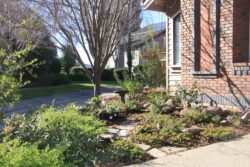
You’ll need to stop at the gatehouse entrance. Tell the security guard that you are going to Cyn Coulouthros’ house, and provide the address.
Showcase Feature
This artistic and inviting garden was designed and installed by Cyn Coulthros, owner of YesPlease. Garden. The lush front garden, with its gentle mounds that enhance drainage, contains a charming mix of manzanita, coffeeberry, California lilac, ferns, coast live oak, toyon and silk tassel, whose varying textures, colors, and heights mingle and repeat in pleasing patterns.
On the way to the back garden you’ll pass through that ubiquitous landscape feature—the utility zone! Hollyleaf cherry, coffeeberry, mahonia, and California lilac ‘Ray Hartman’ enliven this section of the yard.
In the back garden a dry-stacked moss rock retaining wall holds back the slope, which encompasses a dry stream bed that angles across the space.
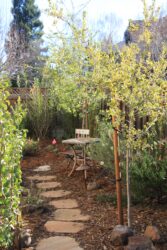 California lilac, manzanitas, and yarrow have been planted around the mature western redbud on the left side of the slope. On the right are prostrate coyote brush, coyote mint, and an interweaving of white and blue sages. Citrus (lemon, lime, grapefruit, and mandarin)—favorites in the family cuisine— are nestled on the hillside.
California lilac, manzanitas, and yarrow have been planted around the mature western redbud on the left side of the slope. On the right are prostrate coyote brush, coyote mint, and an interweaving of white and blue sages. Citrus (lemon, lime, grapefruit, and mandarin)—favorites in the family cuisine— are nestled on the hillside.
The side garden has been densely planted with two coast live oaks, many California lilacs, and sugarbushes in order to help cool the house. This hidden garden has developed into a shaded respite, scented with honeysuckle, coyote mint, and sages, and a cozy seating area for two.
If you love manzanitas and California lilacs this garden, containing nine types of manzanita (‘Emerald Carpet’, ‘John Dourly’, ‘Pacific Mist’, ‘St. Helena’, ‘Sentinel’, ‘Wayside’, ‘Pt. Reyes Bearberry’, ‘Carmel Sur’, ‘Little Sur’) and seven kinds of California lilac (‘Ray Hartman’, ‘Centennial’, Frosty Blue’, Buckbrush’, Pt. Reyes Creeper’, ‘Valley Violet’, and ‘Point Sierra Maritime’) is for you!
Other Garden Attractions
• Cyn loves rocks, and you’ll see a lot of boulders, cobblestones, pebbles, and flagstone in this garden. They protect the roots of new and established plants, provide shelter and sunning spaces for wildlife, add structure and volume, and create paths and a natural feel. In this garden moss rock and Calistoga boulders are blended with Noiya River pebbles, Lodi and lava rock, salt-n-pepper granite, slate, and ginger and California gold granite .
Gardening for Wildlife
Quail shelter under the ‘Howard McMinn’ manzanitas that line the back fence. Hummingbirds adore the monkeyflower and penstemon: owls hoot overhead. Boulders provide basking places for lizards. Leaf litter is left for the offspring of butterflies and moths to over-winter in. In order to provide water for wildlife the birdbath nestled in the front fern garden is kept filled and clean.
Keystone species (watch this talk by Doug Tallamy!)
Keystone species—our own, local ecological powerhouse plants—in this garden include coast live oak, holly leaf cherry, California lilac, manzanita, lupine, coyote brush, buckwheat, coffeeberry, honeysuckle, sage, elderberry, and penstemon.
Garden Talks
12:00 “What a homeowner can generally do themselves, and what a landscape designer should probably do: This talk will include a discussion of creating the plan, grading, designing and installing irrigation, sourcing and spotting the plants, and planting” by Cyn Coulouthros
At least partially wheelchair accessible? Yes.
The post Cyn Coulouthros’ garden appeared first on Bringing Back the Natives Garden Tour.
Jim and Laurie Ulrick’s garden 🐦 3 Mar 3:19 PM (last month)
Showcase Feature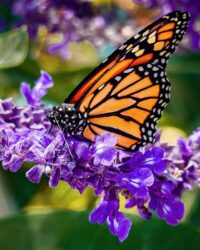
Jim, who has been gardening with California native plants for more than forty years, has combined native trees, shrubs, and perennials with edibles and wildflowers to create a beautiful and productive garden. In the large front yard mature manzanita, toyon, California lilac, and Pacific wax myrtle planted adjacent to the attractive open board fence create a living privacy screen, while delighting birds and bees.
Repetition of plants creates a calming effect, while providing visual interest: note the two kinds of flowering currant (pink and red), three types of manzanita (‘Howard McMinn,’ ‘Sentinel,’ ‘Dr. Hurd,’) and buckwheat (naked, rosy, sulphur) and five kinds of California lilac (‘Point Sierra,’ ‘Dark Star,’ ‘Frosty Blue,’’ ‘Julia Phelps,” and ‘Island’).
The garden was designed by Buena Luna/Cummings Landscape Architecture, and installed by Jim and the Cummings team.
Other Garden Attractions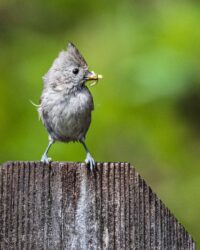
• Check out the orchard in the front garden: among the sixteen fruit trees are the sweet-tart Ashmead’s Kernal russet apple, which originated in the 1700s: Winter Nellis pear, which arrived in the States from England in 1823: three varieties of pluot – flavor grenade, flavor king, pluerry; and more.
• The fence, gates, raised garden beds, and benches were made from two large redwoods that were taken down and milled onsite. Jim designed the fences, the Japanese style gate that leads to the front door, and the Maybeck-influenced side gate. A woodcarver, Jim also carved the floral design on the top of the gate adjacent to the orchard.
• The outdoor shower drains into the garden.
• Cement board siding has been installed on the house and garage for fire protection.
• The back garden contains a meadow created from Larner Seeds’ “Hills of California” wildflower mix.
Gardening for Wildlife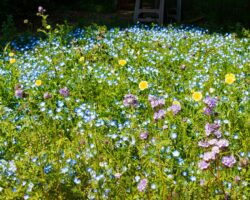
Acorn woodpeckers gather acorns and catch insects on the wing: the smaller Nuttall’s woodpeckers search for insects in the crevices of tree trunks, branches, and twigs, while Downy woodpeckers forage for insects from the stems of plants, or from galls. Cedar waxwings, pine siskins, and golden crowned sparrows have been seen in the garden, as have migrating hermit thrushes, which stop in to forage for insects on the ground, and to search for berries. Diminutive oak titmice, which mate for life, have nested in the bird houses Jim has set out for them.
Hummingbirds sip water from the shallow fountain in the back garden, and nectar from the cream-to-pink urn-shaped manzanita flowers: this winter-blooming plant provides food when hummingbirds, and native bumblebees, need it. Hummingbirds are also attracted to the tubular, fire-engine red blossoms of our native fuchsia and penstemon.
Red-shouldered hawks watch the avian action from above, and occasionally, from nearby.
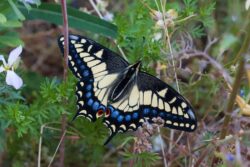 Monarch, swallowtail butterflies and skippers sip nectar from the many native blossoms available to them. A rambunctious Dutchman’s pipevine climbs up the fire-resistant open mesh fence in the back garden; the pipevine has attracted the beautiful iridescent blue-black pipevine swallowtail butterfly, which can only lay eggs on this plant. See if you can spot any caterpillars in the garden.
Monarch, swallowtail butterflies and skippers sip nectar from the many native blossoms available to them. A rambunctious Dutchman’s pipevine climbs up the fire-resistant open mesh fence in the back garden; the pipevine has attracted the beautiful iridescent blue-black pipevine swallowtail butterfly, which can only lay eggs on this plant. See if you can spot any caterpillars in the garden.
About ten kinds of native bees, including yellow-faced bumblebees flat-tailed leafcutter, and carpenter bees, buzz the plants in this garden.
Salamanders find shelter in moist, shady places, and a bat house waits hopefully for inhabitants.
Keystone species (watch this talk by Doug Tallamy!)
Keystone species—our own, local ecological powerhouse plants— in this garden include coast live oak, huckleberry, pink and red flowering currant, snowberry, California lilac, aster, buckwheat, manzanita, sage, coffeeberry, and penstemon.
Green Home Features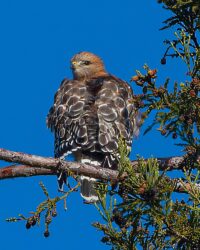
Solar panels reduce the household’s PG&E bill. A whole-house fan keeps the house cool (no air conditioner is needed). Solar hot water panels heat the water in the swimming pool.
Garden Talks
11:00 “Long-term maintenance and regeneration of a mixed native, habitat, and edible garden” by Jim Ulrick
At least partially wheelchair accessible? No
Parking – Parking will be tight. Be prepared to walk a block or so.
The post Jim and Laurie Ulrick’s garden 🐦 appeared first on Bringing Back the Natives Garden Tour.
Roger and Amy Aines’ garden 3 Mar 3:10 PM (last month)
Showcase Feature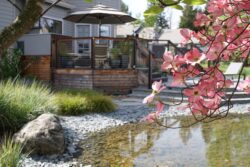
Roger and Amy spent a lot of time hiking in the Livermore hills observing and photographing the natural world in order to replicate it in their own garden: their hope was to create a landscape reminiscent of what this area might have looked like three hundred years ago. The garden their son, Ethan, and landscape architect Joseph Huettl designed fulfilled their dreams.
Low-maintenance, water-conserving, and wildlife-attracting native bunchgrass meadows replaced the front and back lawns. The back garden contains a seep, which is filled with the bright yellow blossoms of the seep monkeyflower in spring and summer. After passing under a large, single-stone bridge the water emerges as a slender stream that splashes through the garden, flows past sedges and rushes, cascades down small drops, and wends its way to its final destination in a tranquil pond.
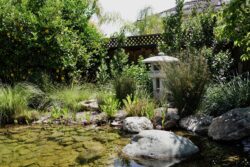 Blueschist boulders local to the area are scattered about, contributing to the lost landscape ambience of this lovely landscape.
Blueschist boulders local to the area are scattered about, contributing to the lost landscape ambience of this lovely landscape.
The slope on the sunny side of the house was planted with an attractive mix of hardy native trees and shrubs, including oak, toyon, manzanita, sage, and bunchgrasses.
Drop down in one of the many seating areas in this peaceful garden—you won’t want to leave.
Other Garden Attractions
• Sycamores, once emblematic of Livermore, were planted in front of the house: seventeen species of butterflies and moths, including the beautiful Western tiger swallowtail, can lay eggs on these fast-growing trees.
• The dense plantings outcompete weeds.
• No pesticides are used in this—or any!—Tour garden.
Gardening for Wildlife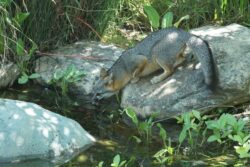
Thirty-two species of birds, including Nuttall’s woodpeckers, hermit thrushes, cedar waxwings, Western bluebirds, red-breasted sapsuckers, and Western tanagers have been seen in the garden.
The pond is a magnet for wildlife: owls bathe in and foxes drink from it. Recently, three racoon kits splashed and tumbled about in its shallows—under the unamused eye of their mother, who had clearly wanted to teach them how to catch native aquatic snails. Not long ago a great egret spent a couple of hours plucking mosquito fish out of the pond. A dozen species of dragonflies and damselflies have been seen near the pond: eleven types of bumblebees and wasps pollinate the plants that grow adjacent to its banks.
Morning trail cam viewings revealed a bobcat strolling through the yard, among other interesting wildlife sightings.
Keystone species (watch this talk by Doug Tallamy!)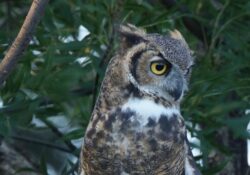
Keystone species—our own, local ecological powerhouse plants— in this garden include coast live oak, holly leaf cherry, vine and bigleaf maples, California lilac, currants, huckleberry, manzanitas, sages, madrone, coffeeberry, and penstemon.
Green Home Features
A ducted heat pump heats and cools the house. Solar panels generate energy that reduces the Roger and Amy’s PG&E bill. They no longer pay for gas as their two electric cars are charged at home, using energy from the solar panels.
Garden Talks
11:00 “Water features for Livermore gardens” by Roger Aines
Wondering what to make for dinner? Try this great recipe!
“My daughter shared this recipe a few years ago, and it’s been a staple in my freezer ever since. It’s a great way to get your greens. My family loves it too. I use olive oil instead of coconut oil and two leeks from Trader Joe’s instead of onion. I skip the garlic and lime juice too because I love the pure flavor profile of all these vegetables together. I discovered many ‘green soup’ recipes online when I was searching for the link to this one. Lots of flavor options and vegetables that you can add – especially if you have a supply in your garden. Enjoy!” Amy Aines
Green Soup recipe
At least partially wheelchair accessible? No
The post Roger and Amy Aines’ garden appeared first on Bringing Back the Natives Garden Tour.
Gonzalo Mannucci and Joe Lapka’s garden 3 Mar 2:33 PM (last month)
Showcase Feature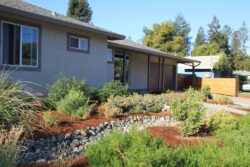
When Gonzalo and his husband bought this large corner lot in 2021 they knew the large Bermuda grass lawns and London plane trees had to go. In their place Gonzalo, owner of Planetscaper Landscape Architecture, envisioned a resilient, eco-focused landscape that contained flourishing California native plants and edibles, retained rainwater on-site, and was built of mostly locally-sourced materials.
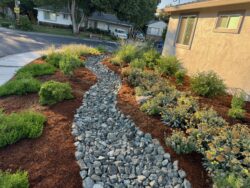 Gonzalo loves designing gardens with native plants! He says, “California natives provide such a rich plant palette: there is every texture, color, shape, and size you can imagine.” In his own front garden, the sunny areas bordering the sidewalk have been planted with attractive swaths of prostrate coyote brush, fragrant coyote mint, and blue grama grass, with their cheerful, fine-leaved seed heads. Shadier areas of the front garden are home to Island alum root, and sword ferns. Scattered throughout the garden are manzanita, California lilac, coffeeberry and toyon, which provide stability and structure throughout the year.
Gonzalo loves designing gardens with native plants! He says, “California natives provide such a rich plant palette: there is every texture, color, shape, and size you can imagine.” In his own front garden, the sunny areas bordering the sidewalk have been planted with attractive swaths of prostrate coyote brush, fragrant coyote mint, and blue grama grass, with their cheerful, fine-leaved seed heads. Shadier areas of the front garden are home to Island alum root, and sword ferns. Scattered throughout the garden are manzanita, California lilac, coffeeberry and toyon, which provide stability and structure throughout the year.
The downspouts that collect water from the roof drain into dry creek beds that meander across the front and back gardens. These swales allow the rainwater to seep slowly into the soil: this keeps the garden green longer, protects nearby Turtle Creek from scouring, and helps replenish the aquifer.
The bulk of the materials used in this garden—such as gravel from local quarries, and the Calstone pavers, with their permeable sand joints—were sourced from within 80 miles of the house.
A gigantic RV pad in the back yard was demolished, and replaced with pomegranate and citrus trees. More than one hundred lush-looking, water-conserving Point Molate red fescue, planted from 6” stub pots, brighten the back garden.
Other Garden Attractions
• The family cat is kept indoors—both to keep her safe, and to protect birds.
• Restrooms are available in nearby Willow Pass Community Park, at 2748 E Olivera Rd, Concord, at the corner of Salvio St. and Olivera Rd.
Gardening for Wildlife
Butterflies, moths, bees and birds are attracted to this garden.
Keystone species (watch this talk by Doug Tallamy!)
Keystone species—our own, local ecological powerhouse plants—in this garden include holly leaf cherry, huckleberry, currant, California lilac, manzanita, coffeeberry, coyote brush, and sage.
Green Home Features
Gonzalo and his husband both drive electric vehicles, which are charged at home. Three Solatubes concentrate natural light in the house, so that interior lights are used less.
At least partially wheelchair accessible? yes
Great recipe!
Olive Walnut Pasta
I love this meal because it is: Rich in flavor, comforting, healthy and comes together quickly (under 30 minutes). It is high in protein. It elevates the simple, humble ingredients into something special. From the NYT Cooking Recipes For those without a subscription, PDF attached.
The post Gonzalo Mannucci and Joe Lapka’s garden appeared first on Bringing Back the Natives Garden Tour.
Nora Trentacoste and Jay Slean’s garden 3 Mar 2:25 PM (last month)
Showcase Feature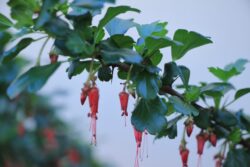
When Nora and Jay bought their home in 2011 the garden consisted of a lawn and nearly 100 prize-winning roses: also inherited were the garage full of pesticides that were used to maintain them. After taking the chemicals to the household hazardous waste disposal facility and finding homes for 80 of the roses (the remaining roses—kept to honor the former owners—border the house), they sheet mulched, then designed and planted their native garden themselves.
Nora has been interested in ethnobotany since she was a child: edible natives are still her passion, which fortunately, Jay shares. Ask about barberry berries (rated by Nora as “delicious!”), fruit from the pink flowering currant (beloved by neighborhood children)—and the brew Jay makes from mugwort.
A buckeye and a large St. Helena manzanita grow out of (and into!) massed moss rock boulders. A mini soap root forest flourishes near the manzanita: Nora said she ”Loves soaproot: their wavy leaves, the drama of their height, and it’s so romantic that they bloom in the evening.”
Other Garden Attractions
• While supplies last native cuttings and seeds, samples of native edibles to taste, and recipes, will be available.
• No pesticides are used in this—or any!—Tour garden.
• Spiky gooseberry was strategically planted under a window as a theft deterrent.
• The vintage grape stake fence creates a 1950’s look.
• Plants are watered only while they are getting established.
Gardening for Wildlife
Hummingbirds, towhees, finches, mockingbirds and jays frequent the garden. Monarch butterflies lay eggs on the milkweed, viceroy butterflies flutter through, and longhorn and carpenter bees buzz about. Crickets can be heard chirping in the evenings.
Keystone species (watch this talk by Doug Tallamy!)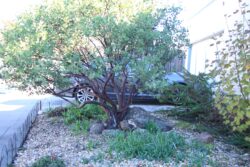
Keystone species—our own, local ecological powerhouse plants—in this garden include currant, California lilac, manzanita, buckwheat, elderberry, and penstemon.
Garden Talks
1:00 “Edible California native plants” by Nora Trentacoste
At least partially wheelchair accessible? yes
The post Nora Trentacoste and Jay Slean’s garden appeared first on Bringing Back the Natives Garden Tour.
Yen Bui’s garden 3 Mar 2:00 PM (last month)
Showcase Feature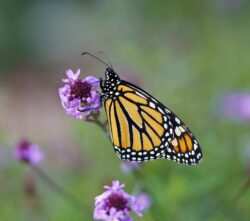
When Yen and Hai bought the house in 2022, this large corner lot contained two huge palm trees, lawn, and an eclectic collection of non-native shrubs. Shortly after purchasing the home they had the palms removed; then these hardworking DIYers took the rest of the garden down to bare dirt. As the soil was heavily compacted, they then covered yard with a thick layer of wood chips (like, 6 to 8 inches).
Yen is passionate about gardening for wildlife: knowing the ecological value of keystone species she and Hai planted a coast live oak, as more species of butterflies and moths can lay eggs on this tree than any other. Yen also chose a pleasing array of California lilac, manzanita, sage, buckwheat, and coffeeberry, which provide structure and stability, and keep the garden green year-round.
Their garden is a certified Monarch Waystation: meaning the garden contains at least 10 narrowleaf milkweed plants (as milkweed is the only plant the monarch can lay eggs on, and narrow leaf milkweed is our local species); numerous nectar plants, such as goldenrod, lupine, and buckwheat. And, they don’t use pesticides (of course!).
 The beautiful wildflower meadow in the front of the house—a colorful and rambunctious mix that includes orange poppies, baby blue eyes, purple Chinese houses and gilia, yellow goldfields and tidy tips, pink clarkia—has been a great conversation starter with passersby: people have pulled their cars over to take photos, or knocked on the door to ask for seeds.
The beautiful wildflower meadow in the front of the house—a colorful and rambunctious mix that includes orange poppies, baby blue eyes, purple Chinese houses and gilia, yellow goldfields and tidy tips, pink clarkia—has been a great conversation starter with passersby: people have pulled their cars over to take photos, or knocked on the door to ask for seeds.
To create more room for plants—and more plants for wildlife—concrete was jackhammered out of the parking strip. This low-maintenance, water-conserving garden was designed and installed by Yen and Hai.
Other Garden Attractions
• New plants are watered by hand once a week until they are established. (The established plants receive occasional water.)
• You are invited to take a seat under the shade cover in the back yard and enjoy this peaceful garden.
• Rain barrels capture water from the roof.
• Compost from a tumbler and pile helps improve the soil.
Gardening for Wildlife
Nectar, pollen, acorns, berries, and insects (which chicks need to be fed while they are in the nest, and even after they leave it), and a bird bath, which provides fresh, clean water, invites flying friends of all types to visit. Bumble- and many other types of native bees are commonly seen on the sages, California lilacs, buckwheats, and buttercups. Monarch butterflies lay eggs on the narrowleaf milkweed, which is spreading about the garden, much to Yen’s delight. Anise swallowtail, painted lady, blue azure, acmon blue, painted lady butterflies, and a variety of moths, including the orange tortrix, sip nectar from the flowers in this garden. Hummingbirds, white-crowned sparrows and mourning doves flit about, searching for insects, nectar, and seeds. 
Keystone species (watch this talk by Doug Tallamy!)
Keystone species—our own, local ecological powerhouse plants—in this garden include coast live oak, hollyleaf cherry, California lilac, currant, manzanita, California rose, lupine, goldenrod, sage, buckwheat, native strawberry, coyote brush, honeysuckle, and penstemon.
Green Home Features
Yen and Hai have solar panels, an electric vehicle, and cook on an induction range.
Garden Talks
12:00 “Garden Metamorphosis: How we transformed our lawn into native plant garden and butterfly sanctuary” by Yen Bui
At least partially wheelchair accessible? Yes
The post Yen Bui’s garden appeared first on Bringing Back the Natives Garden Tour.
Tim Vendlinski’s garden 3 Mar 1:48 PM (last month)
Showcase Feature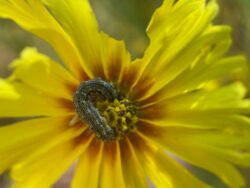
The paths in this beautiful, elegant, and mature garden, which was designed by Tim, are bordered by a variety of evergreen shrubs from the coastal chaparral community, such as manzanita, California lilac, and sages—white, Cleveland, and St. Catherine’s lace—that provide greenery and stability throughout the year.
The front garden has something in bloom almost year-round: the cream-to-pink blossoms of the manzanita are the first to appear, in late winter, delighting hummingbirds and the native bees that buzz pollinate it. Lavender-to-purple brodiaea’s and purple-to-blue California lilac bloom in the spring and summer. From late summer through fall drifts of fire-engine red fuchsia brighten the garden.
In the natural and mostly hands-off back garden are plants from the coastal prairie: pink clarkias, orange poppies, and a riot of yellow tarweeds that delight native bees in the spring and summer. Bright yellow native sunflowers provide bursts of color in the fall and attract finches, which glean seeds from the dried flower heads long past the time when we would think there would be nothing there to eat any longer. Mugwort and Sonoma and black sages, fuchsia and pipevine find the places they are happiest and tumble over each other in wild profusion.
Native shrubs, such as toyon, and a variety of heritage fruit trees (Babcock and Suncrest peach, Blenheim apricot, and Seckel pear) line the fence.
Tim’s garden, the nearby traffic circle, and the Park Blvd. triangle (the latter two planted and tended by Tim, and described below) are ecological stepping stones for birds, which flit from one site to the other.
Other Garden Attractions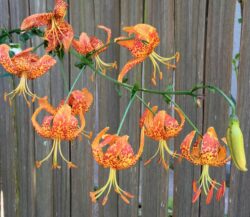
• Check out the attractive traffic circle at the south end of the block (at the intersection of Grosvenor and Holman), which Tim planted with a buckeye, manzanita, sage, and fuchsia, and tends.
• You might want to bring a picnic lunch to enjoy on log seats in the oak-studded Park Blvd. triangle. Tim planted these stately coast live oaks. This former dumping ground (think washing machines and lots of trash), was cleaned up, officially adopted, planted, and is tended by Tim, and now contains manzanita, California lilac, coffeeberry, sage, buckwheat, monkeyflower, and a fescue meadow.
• Deadheading in Tim’s garden, and at the traffic circle and Park Blvd. triangle is kept to a minimum: dried flowerheads are left on the plants to provide food for birds.
• A large boulder in the front garden at the house creates visual interest.
• Tim grows oaks for use in restoration projects, and at times has 200 of them in the nursery in the back yard.
Gardening for Wildlife
Resident and migrating songbirds are seen in the garden, as well as Downy and Nuttall’s woodpeckers, Stellar jays, barn owls, and Cooper’s hawks. Innumerable native bees, including leaf-cutter, summer longhorn, sweat, and carpenter, buzz from flower to flower collecting pollen. Flocks of cedar waxwings visit the garden in winter to feed on the toyon berries. Towhees and Bewick’s wrens have nested in the grape.
A hanging birdbath in the front garden, and a small water fountain in the back provide birds with clean sources of water. These are cleaned frequently, and kept off the ground to protect the birds from cats.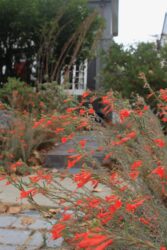
Tim leaves the leaves—to improve the soil; provide protection for the pupae of butterflies and moths, which overwinter in leaf litter; and to avoid throwing away chrysalis’ and cocoons that are attached to dried leaves. Leaves are so valuable that Tim intercepts them in the gutter and uses them on his lot. Leaf and brush piles provide places in which small creatures can shelter: newts and salamanders spend their days resting in cool, shady areas under log piles, which Tim said, he, “never disturbs.”
Four songbird nesting boxes in the back yard invite avian friends to settle in and raise their families in this welcoming environment.
Keystone species (watch this talk by Doug Tallamy!)
Keystone species—our own, local ecological powerhouse plants— in this garden include vine maple, pink flowering currant, thimbleberry, California lilac, hazelnut, dogwood, manzanita, lupine, California sunflower, buckwheat, sage, coffeeberry, snowberry, sagebrush, madrone, and penstemon.
Garden Talks
12:00 “Immerse yourself in nature” by Tim Vendlinski
At least partially wheelchair accessible? No
Parking – Is allowed only on the east side of the street. Parking will be tight: be prepared to walk a block or two, and don’t block the neighbor’s driveways.
The post Tim Vendlinski’s garden appeared first on Bringing Back the Natives Garden Tour.